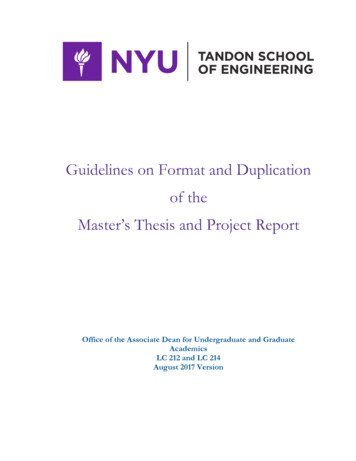
Transcription
Mazella FrancoisMaster Degree Project Final Report“Design and manufacturing of awelding-jig for tailor-madebicycle frames”1
Mazella FrancoisAbstractThe handling behavior is a complex system influenced by many parameters. While many components can improvethe comfort or performances of a mountain bike, the frame stays the main component that will define its handling.Indeed, as explained in this report literature review, each geometrical parameters of the frame influences greatlythe bicycle handling. Every rider being different in anatomy or style of riding, it is necessary to adapt the frame toeach rider to reach the best level of performances. The core of the tailor-made manufacturing of a bicycle is thepositioning and holding of the tubes relatively to each other, a process that is carried via the use of a customizablewelding-jig. This report analyses the current welding-jigs available on the market and describes in details thedesign and manufacturing of a unique welding-jig for tailor-made bicycle frame for Nicolai GmBH, a Germancompany specialized in the manufacturing of high end bicycle frames. In addition, this report introduces the readerto an internet form listing all the combination of the bicycle industry’s standards used by Nicolai GmBH. Thisinternet form has for purpose to facilitate the understanding of the customer willing to buy a tailor-made bicycleframe.The welding-jig has been designed on the Computer Aided Design software SolidWorks and is made of anassembly of Bosch Rexroth aluminum extruded profiles and their standard accessories and parts machined atNicolai GmBH. Besides ensuring the positioning and holding of the different elements of a bicycle frame, it hasthe particularity to:-Display every geometrical parameter of a bicycle frame.-Be able to build a broad range of bicycle frame sizes.-Give an easy access to all the parts of the frame to the welder.-Reduce the number of aligning process in the manufacturing of a bicycle frame.-Be easily movable.This report presents also the calibration process of the welding jig and the description of its setting process. Thewelding-jig presented in this report has been tested successfully at Nicolai GmBH for the manufacturing of ahardtail bicycle frame. It is also highly appreciated by the technicians and engineer using it.2
Mazella FrancoisSammanfattningEn mountainbikes köregenskaper är ett komplext system som påverkas av manga parametrar. Många av cykelnskomponenter kommer påverka komforten och köregenskaperna, men det är ramen som är den mest centralakomponenten och det är den som kommer difinera dess köregenskaper. Som deet framgår i rapporten, kommeralla ramens geometriska parametrar kunna ha stort inflytande över dess egenskaper. Eftersom alla cyklister harolika anatomy och körstil är det nödvändigt att anpassa ramen utifrån individen för att maximera prestandan.Kärnan av skräddarsydd tillverkning av cyklar är kunna anpassa ramens rör I förhållande till varandra, en processsom genomförs med anpassningsbara svetsjiggar. Denna rapport analyserar de svetsjiggar som finns tillgängligapå marknaden och beskriver I detalj designen och tillverkningen av en unik jig som tillverkas av Nicolai GmBH,ett tyskt företag som är specialiserade på tillverkningen av high-end cykelramar. Utöver detta introduceras läsarentill en internetsida som listar alla kombinationer av cykelindustrins standarder som används av Nicolai GmBH.Internetsidan har till uppgift att underlätta förståelsen för kunden som är villig att köpa en skräddarsydd cykelram.Svetsjiggen är designad I CAD-programmet SolidWorks. Den är byggd i Bosch Rexroth extruderadealuminiumprofiler, och deras standard tillbehör är tillverkade på Nicolai GmBH. Utöver att säkerställa att delarnahamnar på rätt position på cykelramen har den även följande egenskaper:-Visa ramens samtliga geometriska parametrar.-Kunna tillverka många olika storlekar av ramar-Underlätta åtkomligheten av ramens alla delar för svetsaren-Underlätta riktningsarbetet vid tillverkningen av cykelramen-Vara enkel att flyttaRapporten redovisar även kalibreringen av svetsjiggen och beskriver inställning processen. Den Svetsjiggen harframgångsrikt testats för tillverkning av en cykelram på Nicolai GmBH. Ingenjörer och tekniker som kommer attanvända den är nöjd med resultatet.3
Mazella FrancoisAcknowledgmentsI would firstly like to thank Karlheinz Nicolai, CEO of Nicolai GmBH and head of Engineering, for giving me theopportunity to carry my master thesis in his company, for the interesting project he decided to give me and for thetrust he put in me for letting this project into my hands from its start to its end.I would like to thank Marcel Lauxtermann, my supervisor at Nicolai GmBH, for all the knowledge he shared withme and his availability during the start of my project. I would also like to thank him for giving me the opportunityto travel to the United Kingdom with him and for the value he gave to my opinions about the company’s products.I would like to thank my coordinator at KTH, Lasse Wingård, for trusting me with the progression of my project,for his valuable advice regarding the writing of my report and simply for his welcome and guidance during thosetwo years of exchange in Sweden.I would also like to thank specially Daniel Jahn and all the racing team Nicolai BikeBauer for their support duringmy stay in Germany, for all the time spent together on and off mountain bike races and the insight into the Germanracing world they gave me.Finally, I would like to thank all the employees from Nicolai GmBH for their warm welcome and for making mefeel as a proud member of their family.4
Mazella FrancoisContents1Introduction . 62Literature study . 73452.1History of mountain biking . 72.2Geometry of a bike frame . 82.3Evolution of mountain bike frame’s geometry over the years . 132.4Existing welding jig designs . 17Nicolai GmbH - company, products and processes . 253.1Nicolai GmBH history . 253.2Actual frame production processes at Nicolai GmBH . 263.3Analysis of Current tailor made jig at Nicolai GmBH. 48Project development . 504.1Requirements for welding jig . 504.2Definition of the range of modulation . 524.3Development of a kinematic diagram . 614.4Design of the welding jig on SolidWorks . 644.5Manufacturing of the welding jig . 764.6Calibration of the welding jig . 894.7Test and welding of a frame . 102Conclusion and discussion . 1085.1Project conclusion. 1085.2Project discussion and reflections . 108Appendices . 1115
Mazella FrancoisIntroductionNicolai GmBH is a small German company founded in 1995 by Karlheinz Nicolai. This company manufactureshigh-end bicycles and provides a personal service to the customer unequalled on the market. Indeed, NicolaiGmBH offers, besides regular sizes, tailor-made bicycles regarding the geometry but also the aesthetic of theproduct such as different colors of anodization or powder-coating.The current manufacturing process for tailor-made bicycle frames is problematic because the use of the currentwelding-jig increases excessively the workload on the engineer and technicians. Therefore, Mr. Nicolai plannedto design and manufacture in-house a new welding jig for tailor-made bicycle frames.A welding-jig is the tool used for positioning and holding the different components of a frame according to acontrol data that is the bicycle frame geometry. The aim of this project will therefore be to analyze the bicycleframe geometry parameters as well as studying the welding-jig designs already existing on the market for finallyproposing an adequate design of welding-jig on the CAD software SolidWorks.The manufacturing of this design will then be partly carried at Nicolai GmBH with the manufacturing processesand machines available and partly outsourced to suppliers. Finally, when assembled, the welding-jig will becalibrated at Nicolai GmBH and tested thoroughly to ensure its proper working. The project should conclude onthe training of the technicians for the setting of the jig to ensure that all the knowledge gathered during the projecthas been transmitted and no questions are left unanswered.6
Mazella FrancoisLiterature studyHistory of mountain bikingThe bicycle is an invention nearly 200 years old and has evolved a lot during this period. In this section we willgo through the mile-stones of the bicycle history to understand the background of this study.The first report of bicycle looking machine goes back to the year 1817, when the Baron Drais invents the“Draisienne”: two wheels linked together by a beam of wood. The propulsion of the Draisienne was made only bypushing on the floor with the feet, this led it to be referenced as the “running machine” 1.Later, in 1861, Mr. Michaux transforms the Draisienne into the “Michaudine” by adding a more reliable steeringsystem and propelling system via a bent axle: Mr. Michaux has just invented the crankset and the pedal.In 1870, with the success of the “Michaudine” and the need for higher speed, the penny-farthing is born. Thisbicycle, first made in wood and later in steel, uses the pedaling system of the “Michaudine” on a bigger frontwheel, which went up to three meters high to allow the rider to keep a relatively low pedaling frequency for thespeed reached, thus causing some obvious safety problem for the rider and the pedestrians around.To bring safety to the rider, the first diamond-shaped frame was created with the two wheels of similar size.However, the smaller front wheel required a transmission system to use efficiently the pedaling power. This led inthe late 1880’s to the first modern-looking bicycle, manufactured in Coventry, U.K. by Starley 2. At this point, thebicycle had found its geometry but many improvements were to be made in the following years.Indeed, in 1888, John Boyd Dunlop, a Scottish veterinarian, developed the first pneumatic tire for bicycle and laterthe rear free-wheel was invented 3. With the free-wheel came the invention of the coaster-brake, increasing thesafety of the rider. Some people where then starting to think about the possibility to use different gears.In the early 1900’s, the first rear derailleur is developed, allowing cyclists of the Tour de France to climb the Alps.Until 1970, bikes were made only to ride on road as race or commuting machines but, finally, Gary Fischer, TomRitchey and Charlie Kelly started a company called MountainBikes, where they manufactured bikes based on acruiser geometry with over-sized tubes, bigger tires and straight handlebar: the mountain bike was born. Themountain bike appealed to the sportsman searching adventure and more adrenaline. Even though at this time themain manufacturers did not follow the trend and concentrated their efforts on road bikes, the mountain bikeattracted a lot of customers and big brands such as Specialized and Trek developed quickly. In 1989 the firstsuspension fork appears, followed finally in 1990 by a full suspension bike 4.In the first decade of the 21st Century, mountain bike moved from an unusual sport to a mainstream one. In the lasttwo decades, many technologies have been adapted to mountain biking such as disc brakes, gear boxes orcomposite materials but the main innovations are still made in the field of the transmission, the suspension and thegeometry of the frame.1Frank Rowland Whitt and David Gordon Wilson. Bicycling science. MIT Press, 1993McGrory, David. A History of Coventry (Chichester: Phillimore, 2003)3Frank Rowland Whitt and David Gordon Wilson. Bicycling science. MIT Press, 19934Mountain-biking. (2016, August,4). Retrieved from Wikipedia: https://en.wikipedia.org/wiki/Mountain biking27
Mazella FrancoisGeometry of a bike frameAs we have seen in the history of mountain biking, the geometry of a bike frame has been the core of its evolution.Indeed, according to the C.O.N.I. manual, bike geometry is the base that will make a bike stable, easy to steer andcomfortable 5. In this section we will go through the basic elements of a mountain bike geometry, the differentcommon terms used to define the handling and we will review some recent scientific articles aiming to understandthe handling of a bike and to find the best frame geometry.Firstly, as we have seen previously, bike frames are mainly designed around the diamond shape since the 19 thcentury. This diamond shape involves two triangles: the front triangle and the rear triangle, joined together by theseat tube (see Figure 1). On a rigid bike frame, also known as hardtail, the front and rear triangle always stays inthe same relative position (see Figure 1). However, in a suspended bike frame, the rear triangle moves relativelyto the front triangle in order to allow the rear axle to follow a certain path (represented by the blue arrow in theFigure 1).Figure 1: Front and rear triangles on hardtail and suspended bike frames.Although nowadays many bikes may be made from hydro-formed aluminum tubes or composite shell, it is possibleto describe every bike frame by an assembly of tubes as seen in the Figure 2.5Federation of Independent Associations of Cycling, Italian National Olympic Committee, Central Sports School,Cycling, 1972.8
Mazella FrancoisFigure 2: Different components of a bicycle frame.Every bike frame, would it be rigid or suspended, is defined by its geometry as seen in the Figure 3. This geometryis composed of angles and lengths between the main tubes of the frame and key-points such as the center of thewheels or the bottom bracket. Although some of the elements of the geometry might be defined differently bysome bicycle manufacturers, the main elements are described as follow in the Table 1.Figure 3: Geometrical parameters of a bicycle frame9
Mazella FrancoisTable 1: Description of the geometrical parameters of a bicycle frameIn a suspended bike the path followed by the axle of the rear wheel is determined by the position of the pivot pointsbetween the chain stays, the seat stays, the front triangle and the shock lever as seen in Figure 4. The number andthe position of those pivot points form what is called the suspension design of a bike.Figure 4: Example of location of pivot points on a suspended bicycle.Many studies have been carried out to analyze the effects of a suspension system on the performance of the bikeand the rider. Indeed, a rear suspension significantly increases the comfort by isolating the rider from vibrationsand reduces his physical stress 6 Furthermore, suspension system can improve the handling of the bike, its stabilityat higher speed and its ability to keep traction while braking or cornering 7.6Henri Nielens and Thierry Lejeune, Bicycle Shock Absorption Systems and Energy Expended by the Cyclist.Sports Med 20047An Off-Road Bicycle with Adjustable Suspension Kinematics, S.A. Needle and M.L. Hull, Journal of10
Mazella FrancoisHowever, if it is easy to understand why a rear suspension might improve the performance and the comfort of abike ride, it is necessary to understand that a suspension system may involve disadvantages such as higher weightor a dissipation of the pedaling power in the suspension system 8.In order to reduce those disadvantages of the rear suspension on a bike frame, many suspension design have beencreated in the last decades. The most common design used nowadays in the bike industry are: the single pivot, thefour-bar linkage with its variants Horst Link and Split Pivot, the virtual point pivot and the unified rear triangle(see Figure 5).Figure 5: Main suspension designs on the market. Source:Michael StanfillIf it is necessary to know the effects of a rear suspension on a bike’s handling behavior, it is important to understandthat a rear suspension design is efficient if only it is combined with a good frame geometry that will fit the rider’sanatomy and type of riding. For the modern mountain bike, the number of parameters influencing its handling andperformance is large. Indeed, every component can transform a bike ride in a pleasure or a nightmare. In order tomake this review relevant to the subject of this project, we will focus in this review only on the geometricalparameters of the frame presented previously in the Table 1.Mechanical Design, September 19978Ari Karchin and M. L. Hull, Experimental Optimization of Pivot Point Height for Swing-Arm Type RearSuspensions in Off-Road Bicycles, Journal of Biomechanical Engineering, 200211
Mazella FrancoisUnfortunately, as described by Wilson 9, the influence of each parameter on the bike’s handling and the interactionbetween those parameters relies mainly on experience.“The balancing and steering of bicycles is an extremely complex subject on which there is a great deal ofexperience and rather little science”While many mountain bike magazines or websites such as Pinkbike.com or Vitalmtb.com review the bikes bytheir abilities to climb well or go downhill fast, a more scientific approach can be taken by describing a frame byits stability, its maneuverability and the position of the rider on it. On this subject, it is easy to find someexperimental feedbacks from bike manufacturers or bike journalists in order to describe the influences of some ofthe geometrical parameters on the handling characteristics. 10Simon Collis, in his complete guide to bike geometryon www.mbr.co.uk , April 2015, and Michael Zaho, in his article: “Geometry, an in depth explanation” onwww.pinkbike.com, September 2009 11, give us a good empirical overview of the effect of each parameters thatcan be summarized as following. Seat tube angle: A steeper seat tube angle brings the rider center of gravity forward over the bottombracket. Therefore, allowing him to transfer more power in the crank and keeping the front wheel fromleaving the ground in steep climbs. The bike becomes more stable and maneuverable in the climbs. Wheel base: A longer wheelbase will increase the stability to the detriment of the maneuverability.Indeed, a longer wheelbase make the bike more difficult to spin. Chain stays length: The chain stays length influences directly the wheelbase, thus influencing the stabilityand maneuverability. Short chain stays will make a bike easier to push and pull in holes or obstacles onthe trail but will bring the center of gravity of the rider closer to the rear wheel, therefore increasing theprobability of the front wheel leaving the ground in climbing conditions. Stand-over height: A lower stand-over height will allow the rider to move more easily on the bike.However, the stand-over is limited by the position of the top-tube that brings stiffness to the front triangleand the seat tube. Bottom Bracket Height: Bottom bracket height is very important when it comes to stability andmaneuverability in corners. Indeed, by lowering the center of gravity of the rider and the bike, it allowsthe rider to keep grip on the tires while leaning in a curve. On the other hand, a bottom bracket too lowwill easily hit obstacles on the trails.9Frank Rowland Whitt and David Gordon Wilson. Bicycling science. MIT Press, 1993Simon Collis, The complete guide to mountain bike geometry, April 2015. Visited the geometry-326498#YVju8B4s68ZEwxJG.991011Michael Zaho, Geometry, an in depth explanation, September 2009, Visited the geometry-2009.html12
Mazella Francois Reach: A longer reach brings the front wheel further forward and increase the wheel base of the bike aswell as leaning the rider forward. Stack: A longer stack brings the head tube higher. It is most of the time used in combination with thereach to define the different frame sizes and adjust the bike frame to the size of the rider. Head angle: With a steeper head angle, the steering becomes quicker and the climbing becomes easierbecause of the increased weight on the front wheel and so a better traction. However, a slacker head anglewill increase stability of the steering and make descending easier by preventing the rider to go over thehandlebar. Top tube length: The longer the top tube length, the longer the bike will feel on a seated position.However, the top tube length is less relevant in mountain biking because in technical sections along theride, the rider is most of the time standing-up on the bike. Indeed, the top tube length is influenced by theseat angle, if the seat angle is low, the top tube length can be long but the reach can be short and thereforethe bike can be very small for the rider in the stand-up position.In order to prove scientifically what experience taught bike manufacturers and riders, many studies have beenconducted to understand the dynamics of bicycles. However, those studies failed in simplifying the equationsobtained and failed in correlating them to the design parameters in order to provide bike designers with a usefulknowledge 12. In his study, John Prince managed to create a model of the dynamic behavior of a road bike whilesteering and translated his results into four design charts. Those charts map the ideal steering geometry (head tubeangle and fork rake), wheel properties (wheel diameter and moment of Inertia), frame geometry (position ofmasses, wheelbase and seat tube angle) and Mass and roll inertia of the bicycle. Even though the parameters’ rangeof John Prince’s study applies to road bike and cannot be correlated to actual mountain bike design because of thedifferent position of the rider on the bicycle and the different use of the vehicle, this study is important for us tounderstand that a small variation of one parameter can lead to great differences in the bike handling.In this section, we described the basic terms related to bike geometry and their influences on the handling of thebike using information collected from scientific studies and empirical knowledge. We will, in the next section,analyze how the geometry of mountain bike has been evolving in the last decade.Evolution of mountain bike frame’s geometry over the yearsMountain-biking is a relatively young activity when it comes to cycling, accordingly, mountain bikes took profitof the experience gathered in cycling to improve their designs. However, the technological development thatappeared in the mountain bike industry the last two decades such as hydraulic disc-braking, hydraulic suspensionand lighter materials allowed mountain bike riders to reach higher speed and riding more technical trails, thus12John prince, An investigation into bicycle performance and design, July 201413
Mazella Francoisrevealed a need to depart from the road bike geometry and develop mountain bike specific geometries andcomponents 13.Even though mountain biking can be separated in several distinct activities (see Appendix 1: Description of thedifferent mountain bike disciplines.) most of the mountain bike frames have a lower head angle, longer wheelbase, longer chain stays and longer top tube length than road bikes in order to fulfill the need of stability. However,since 2010, mountain-bike frames geometry has been evolving more quickly towards longer, lower frames andslacker head angle. In this section we will quantify this evolution via analysis of manufacturers’ data andunderstand the mechanism behind this evolution with an interview with one of the pioneer in this geometryevolution, Chris Porter from Mojo suspension.In order to highlight the evolution of mountain bike geometry on the market, a selection of 5 models from 5different manufacturers have been selected. To have a relevant field of study, those five bike frames all correspondto the same discipline of mountain biking called “enduro “(see Appendix 1: Description of the different mountainbike disciplines.). According to the United States National Bicycle Dealers Association14, in 2011, the threebiggest actors of the bicycle market were Trek bicycle, Giant bicycle and Specialized bicycles. To broaden thestudy, three smaller but nonetheless renown manufacturers such as SantaCruz, Orange bikes and Nicolai have beenselected. The six model geometries used in this analysis are: Specialized Enduro Trek Slash Giant Reign Santacruz Nomad Orange Alpine 160 Nicolai ion 16As we can see in Figure 6 those six mountain bikes have decreased their head angle with an average of 2.2 degrees.It is important to note that one degree of difference in the head angle can modify considerably the steering andhandling of a bike 15. Moreover, the reach and the top tube length have also considerably augmented in the past 6years with a rise of respectively 16.3 mm and 31 mm. Accordingly, the slackening of the head angle and theincrease in reach have led to a wheelbase longer of 56 mm. We can wonder why frame sizes have increased somuch in such a short time, indeed, an increase of 16 mm in reach represent the increment between two bike sizes.If it is reasonably safe to assume that the average height of a mountain bike rider has not increased by 10 cm in 6years (10 centimeters representing the height difference recommended between two bike sizes), we have to findanother reason for this evolution.13Frank Berto,The birth of Dirt: Origins of mountain biking,1999United States National Bicycle Dealers Association, Industry Overview 2015, 2015, Visited the ew-2015-pg34.htm15John prince, An investigation into bicycle performance and design, July 20141414
Mazella FrancoisFigure 6: Evolution of Head angle, Top tube length, Reach and Wheelbase from 2010 to 2016 for Specialized enduro, TrekSlash, Santacruz Nomad, Giant Reign and Nicolai Ion 16.In 2014, Chris Porter, Head of Mojo Suspension, the importer for Fox suspension in the United Kingdom,published a series of three articles about bike geometry on the website ww.mbr.co.uk 16 17. In his article of the 16May, Chris Porter highlight the fact that sizing in the mountain bike industry is irrelevant and only because inspiredfrom road biking. Indeed, in road biking, between two sizes of frames, the seat tube length increases but the reachtends to be nearly identical and a longer stem is fitted on the frame, therefore bringing the handlebar forward andcompensating for the taller rider. According to Chris Porter this technique works for road bike because the cyclistis constantly seated and therefore the weight on the front wheel is not sufficient for the rider to feel a drastic changein the handling capabilities of the bike due to the longer radius of steering. However, this system of sizing cannotbe applied to mountain bike because of the standing up position.Chris Porter, Size matters: why we’re all riding bikes that are too small, 16 May 2014. Visited the LKlYffotBavUwG8X.991617Chris Porter, Size matters part 2: Finding the limits of geometry and sizing, 14 August 2014. Visited 9co2RDLdcfPF4.9915
Mazella FrancoisIn this article, Chris Porter deplores that mountain bike manufacturers still follow the road bike sizing by increasingthe reach between sizes half as much as the seat tube length, leading to bad positioning on the bike for tall riders,which can produce back pain or a feeling of falling over the handlebar in steep sections. More than only bringingproblems to light, Chris Porter experimented with bike geometry and proposed in his second article of the 19August 2014 a series of improvement made on current market bikes. In his q
A welding-jig is the tool used for positioning and holding the different components of a frame according to a control data that is the bicycle frame geometry. The aim of this project will therefore be to analyze the bicycle frame geometry parameters as well as studying the welding











